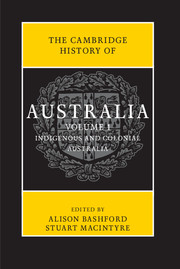Book contents
- Frontmatter
- Contents
- Abbreviations
- List of maps
- List of figures
- List of tables
- Notes on contributors
- Map
- Preface
- Introduction
- PART I
- 1 The past 50,000 years: an archaeological view
- 2 Newcomers, c. 1600–1800
- 3 Convict transportation in global context, c. 1700–88
- 4 The early colonial presence, 1788–1822
- 5 Expansion, 1820–50
- 6 The advent of self-government, 1840s–90
- 7 The gold rushes of the 1850s
- 8 Colonial states and civil society, 1860–90
- 9 Rethinking the 1890s
- 10 Making the federal Commonwealth, 1890–1901
- PART II
- Further reading
- Chronology
- Index
- Frontmatter
- Contents
- Abbreviations
- List of maps
- List of figures
- List of tables
- Notes on contributors
- Map
- Preface
- Introduction
- PART I
- PART II
- Further reading
- Chronology
- Index
2 - Newcomers, c. 1600–1800
from PART I
Published online by Cambridge University Press: 05 November 2013
- Frontmatter
- Contents
- Abbreviations
- List of maps
- List of figures
- List of tables
- Notes on contributors
- Map
- Preface
- Introduction
- PART I
- 1 The past 50,000 years: an archaeological view
- 2 Newcomers, c. 1600–1800
- 3 Convict transportation in global context, c. 1700–88
- 4 The early colonial presence, 1788–1822
- 5 Expansion, 1820–50
- 6 The advent of self-government, 1840s–90
- 7 The gold rushes of the 1850s
- 8 Colonial states and civil society, 1860–90
- 9 Rethinking the 1890s
- 10 Making the federal Commonwealth, 1890–1901
- PART II
- Further reading
- Chronology
- Index
- Frontmatter
- Contents
- Abbreviations
- List of maps
- List of figures
- List of tables
- Notes on contributors
- Map
- Preface
- Introduction
- PART I
- PART II
- Further reading
- Chronology
- Index
Summary
The history of Aboriginal people in Australia spans tens of thousands of years; the history of newcomers to their shores is much shorter. The first known arrivals began in the early 1600s, although were probably preceded by seafarers and fishermen, their visits unrecorded, from islands along the continent's north coast. Visits from European voyagers were part of a broader history of gradually expanding knowledge of the southern hemisphere. At the frontiers of maritime exploration in the fifteenth, sixteenth and seventeenth centuries were the Portuguese, Spanish and Dutch. In 1488 the Portuguese navigator Bartolomeu Dias had rounded the Cape of Good Hope, proving there was ocean south of Africa and in 1498 his countryman Vasco de Gama reached the west coast of India. By 1520 the Spanish navigator, Ferdinand Magellan, had determined that the Pacific Ocean, extending from Patagonia to East Asia, was connected to the Atlantic Ocean. Throughout the sixteenth century, the Spanish drew ever closer to Australia as they searched for the fabled terra australis, a hypothesised continent that often appeared on early-modern maps of the world. These explorers’ attempts were launched mainly from the west coast of South America, from where they reached the Solomon Islands in 1567. In 1605 the expedition led by Pedro Fernandes de Queirós left Peru with hopes of finding the Great South Land and claiming it for Spain. While unsuccessful, the expedition's second in command, Luís Vaez de Torres, sailed through the strait (which now carries his name) that separates New Guinea from the northern Australian coastline. Throughout this period, the Dutch were also active in the region, having entered the Asian spice trade by launching commercial voyages to Banten (Bantam, Java). They consolidated their regional presence when they established the United East India Company or Verenigde Oostindische (VOC) in 1602. The Dutch claim the honour of making the first known European landfall in 1606. From this moment onwards, newcomers arrived continuously, if sporadically (see maps 0.1 and 0.2).
- Type
- Chapter
- Information
- The Cambridge History of Australia , pp. 43 - 67Publisher: Cambridge University PressPrint publication year: 2013
- 2
- Cited by



